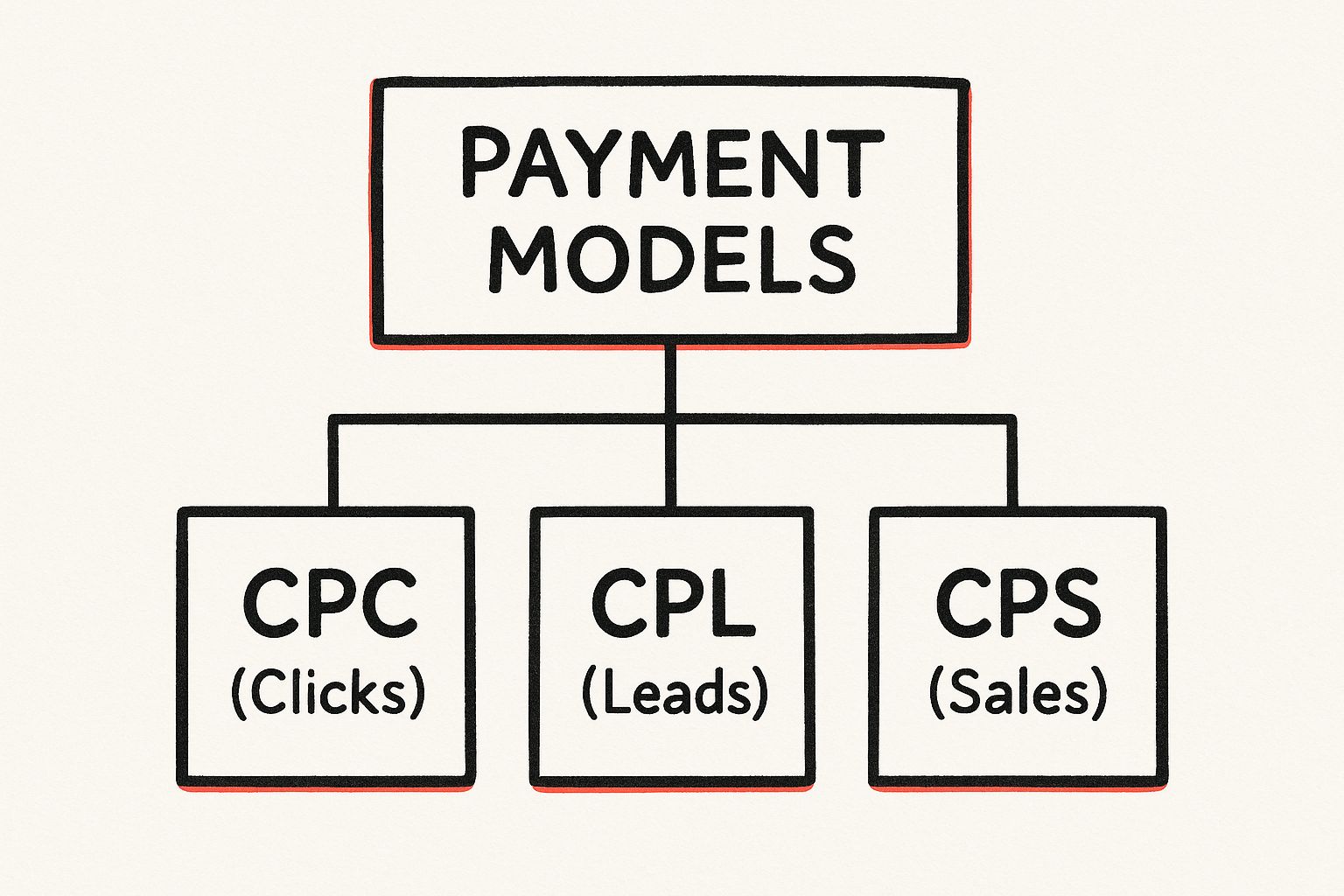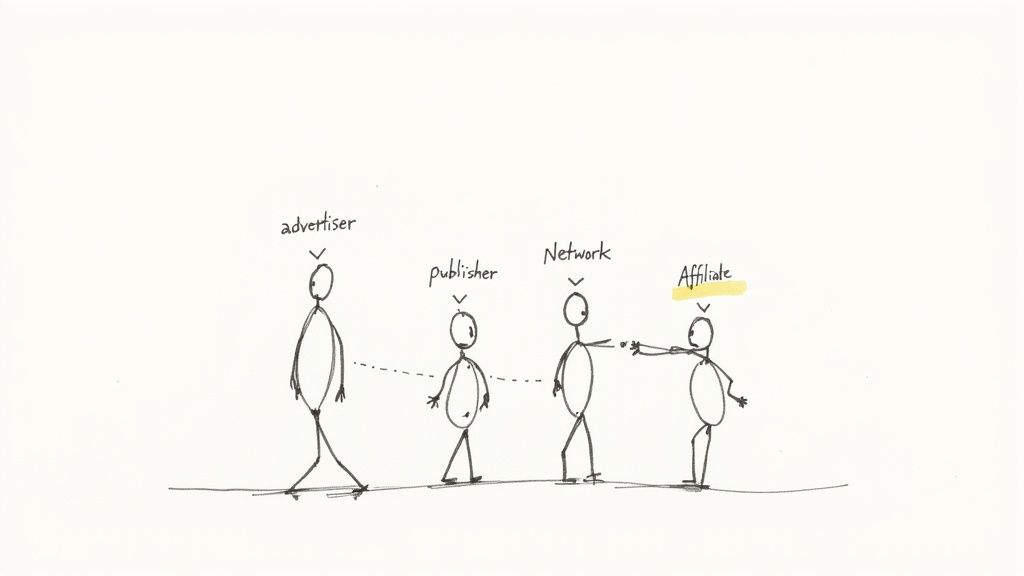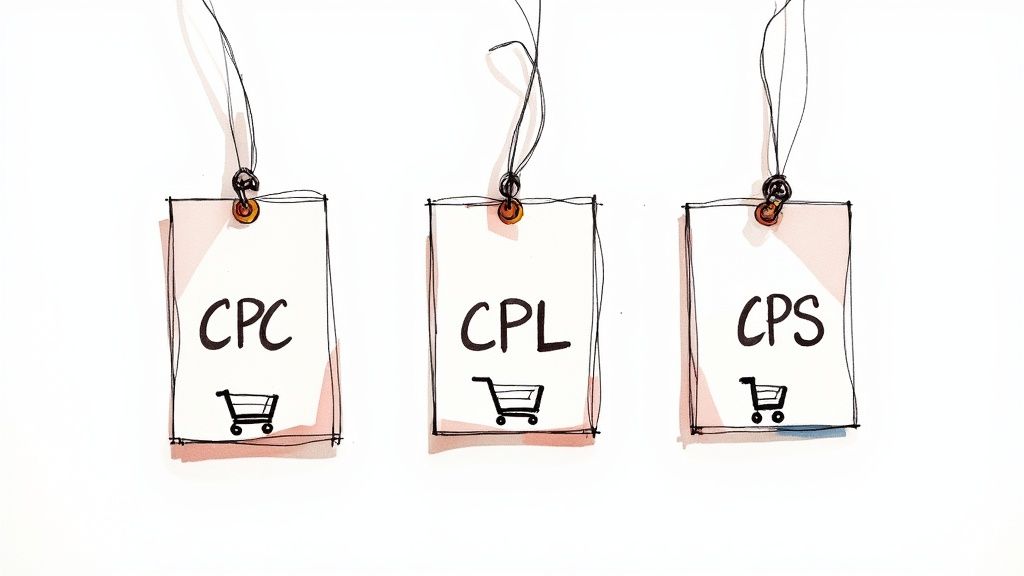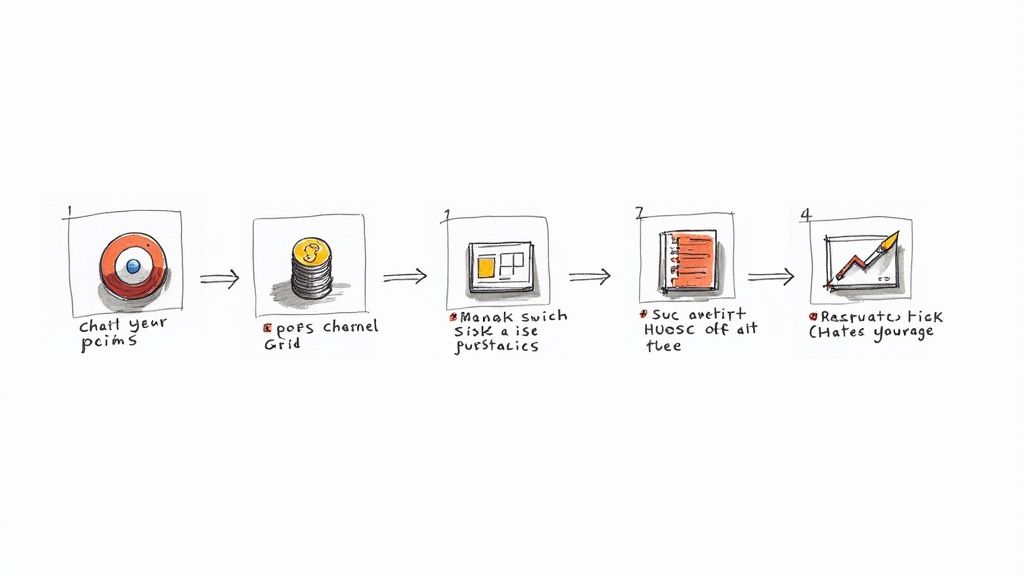What Is Performance Marketing And How Does It Work
Stop paying a chef before you taste the meal. That’s performance marketing. It flips the old "spray and pray" ad model on its head. No more paying for eyeballs and just hoping for the best.
Stop Paying for Promises, Start Paying for Results
Performance marketing isn’t about buying ad space; it’s about buying results. You only pay for specific, measurable actions. Forget shelling out cash for impressions or "potential reach." Your budget is welded directly to tangible outcomes, like a click, a new lead, or a sale.
This model is a game-changer. It shifts the financial risk from you (the advertiser) to the publisher. If a campaign fails to deliver the agreed-upon action, you don’t pay. This built-in accountability is what makes it so lethal for founders obsessed with ROI and lean growth.
"Paying for results instead of promises demands you meticulously track and understand your Google Ads performance metrics."
Ultimately, this model forces everyone to focus on what actually moves the needle, killing wasted ad spend and guesswork.
The Core Payment Models
At its heart, performance marketing runs on a few key payment structures. These models are the engine of any performance-based campaign, connecting your costs directly to specific outcomes.
The infographic below breaks down the three most common ones.

Each model—CPC, CPL, and CPS—aligns with a different stage of the customer journey, from grabbing initial interest to closing the deal. Knowing which to use and when is critical for building a smart campaign and a huge part of learning how to measure marketing ROI the right way.
Understanding the Performance Marketing Ecosystem

To get what performance marketing is, you have to know who’s involved. Think of it as a four-person relay team, each with a specific job to get a customer across the finish line. When they sync up, the result is a smooth, profitable campaign.
The process is simple: a user sees an ad, clicks it, and completes a specific action. Only then does the brand pay. Behind this simple flow, four distinct players make it happen.
The magic of this ecosystem is its built-in alignment. Every player is motivated by the same goal: driving a measurable, valuable action. Success for one means success for all.
This structure creates a transparent and accountable way to generate revenue. But to make it work, you must understand each player's role.
The Four Key Players in Performance Marketing
So, who’s on this high-stakes relay team? Each one brings a critical component to the campaign, from the offer itself to the audience. Success hinges on how well each executes their part.
Here’s a quick breakdown of who does what.
Player | Role | Primary Goal |
|---|---|---|
The Advertiser | The brand selling a product or service. They foot the bill for the completed action. | Generate sales or leads at a profitable Cost Per Acquisition (CPA). |
The Publisher | The person or platform with an established audience (e.g., blogger, influencer, media site). | Monetize their audience by promoting offers and earning a commission on conversions. |
The Network | The tech platform acting as the middleman. They handle tracking, reporting, and payments. | Connect advertisers with publishers, ensure accurate tracking, and make sure everyone gets paid. |
The Partner | Often an agency or an affiliate manager. They manage strategy and publisher relationships. | Maximize the advertiser’s ROI by managing the relationships and daily operations. |
In short, everyone has skin in the game. The advertiser wants results, the publisher wants to earn, the network ensures fair play, and the partner fine-tunes the strategy to make it all work.
Choosing Your Performance Marketing Payment Model

In performance marketing, you don't buy ad space—you buy outcomes. This shift is a game-changer, and it all starts with picking the payment model that perfectly matches your goal.
Think of it like choosing the right tool for a job. You don't use a sledgehammer to hang a picture frame. Each model is built around a specific action in the customer journey, with its own balance of risk and reward.
Choosing the right payment model is the most direct way to control your marketing budget. It forces you to define exactly what a "result" means to your business, turning abstract goals into measurable targets.
Cost Per Click (CPC)
This is the classic. With Cost Per Click (CPC)—also called Pay-Per-Click (PPC)—you pay every time someone clicks your ad. That's it. It’s the most straightforward way to get traffic to your website or landing page.
CPC is perfect for top-of-funnel goals where the main objective is just getting people in the door.
Best For: Driving website traffic, A/B testing ad copy, and building brand visibility fast.
Actionable Example: A new e-commerce store runs a CPC campaign on Instagram to drive as many potential shoppers as possible to its homepage to test product interest.
This model is a numbers game. You win by getting a high volume of relevant clicks for a low cost, which demands constant campaign optimization.
Cost Per Lead and Cost Per Sale
Move down the funnel, and the models get sharper and more tied to your bottom line.
Cost Per Lead (CPL): With CPL, you pay a fixed amount for each qualified lead, like a form submission, newsletter signup, or demo request. It's a fantastic fit for B2B companies or businesses with longer sales cycles.
Cost Per Sale (CPS): Also known as Cost Per Acquisition (CPA), this is the holy grail. You only pay when a click turns into a paying customer. Your ad spend is directly tied to revenue. No sale, no fee.
The entire industry is leaning this way. Paid search, a huge slice of the performance pie, is projected to hit $124.59 billion in the US by 2024. This isn't just a trend; it's a massive shift showing how much brands value paying for real actions. You can discover more digital marketing statistics and trends on SEO.com to see just how big this movement is.
Finding Your Audience on Key Performance Channels
Alright, you’ve picked your payment model. Now, where do you spend the money?
Performance marketing isn't one tactic; it's a mindset you apply across different channels. And each channel is its own universe for finding customers. Picking the right one is everything—it’s how you connect with the right people at the exact moment they’re ready to act.
The secret? Match the channel to your audience’s behavior. Are they actively Googling a solution, or are they mindlessly scrolling Instagram? Knowing the difference is the first step to a campaign that works. If you haven't nailed this down, our guide on how to find your target audience is your next stop.
Search Engine Marketing (SEM)
Think of Search Engine Marketing (SEM) as fishing in a stocked pond. You're targeting people with undeniable buyer intent.
When someone types "best running shoes for flat feet" into Google, they're on a mission. SEM lets you place your ads right at the top of those search results, putting your brand in front of customers who have already raised their hands and said, "I have a problem I need to solve now."
This channel is a goldmine for businesses whose products solve a specific, searchable need. The dominant model here is Cost Per Click (CPC), making it a direct and powerful way to drive qualified traffic straight to your website.
Social Media Advertising
Social media platforms like Facebook, Instagram, and TikTok offer a different superpower: insanely detailed audience targeting.
Instead of waiting for people to search, you go find them. Slice and dice audiences based on demographics, interests, online behavior—you name it. This makes social media a perfect fit for brands whose products appeal to specific lifestyle niches or tight-knit communities.
It’s no surprise social and influencer marketing are becoming the backbone of global performance strategies. The social ad market is projected to jump by 12% in 2025, and 59% of marketers plan to double down on influencer partnerships. Why? A staggering 90% of Gen Z consumers say social content directly influences what they buy. You can dig into more 2025 marketing stats over at Marketing Dive.
How AI Is Supercharging Performance Marketing
The next leap in performance marketing is already here: artificial intelligence. AI is shifting the industry from a game of manual tweaks and gut feelings to a science of predictive optimization.
Think of AI as the ultimate co-pilot for your campaigns. It crunches millions of data points in real-time—far more than any human—to spot patterns and make smarter decisions on the fly. This turns expensive guesswork into a predictable, repeatable science, guaranteeing your budget works harder.
This tech takes over the tedious tasks, making your campaigns more efficient, precise, and profitable. It’s all about finding your best customers automatically and putting your ad spend exactly where it will drive the biggest impact.
Predictive Optimization in Action
So, what does this AI co-pilot actually do? It zeroes in on three key areas that deliver the biggest results for your bottom line.
Automated Bidding: Forget manual bids. AI adjusts them in real-time based on conversion likelihood, ensuring you never overpay for a click or underbid for a high-value customer.
Predictive Audience Targeting: Go beyond basic demographics. AI identifies users who are most likely to convert by analyzing thousands of subtle behavioral signals.
Dynamic Creative Optimization: AI automatically tests thousands of ad variations—images, headlines, calls-to-action—to find the perfect combination that resonates with each audience segment.
By mastering these AI-driven tactics, you shift from reacting to campaign data to proactively shaping outcomes. It's the difference between looking in the rearview mirror and having a GPS for the road ahead.
The industry is betting big. By 2025, a staggering 71% of marketing organizations plan to pour over $10 million into AI, with 83% of CMOs optimistic about its potential. AI makes real-time personalization possible—a critical component for growth.
Get started by exploring the best free AI tools for marketing available now. Brands mastering this are already crushing their revenue goals, as detailed in recent performance marketing trend reports.
Launching Your First Performance marketing Campaign

Enough theory. Results come from action. Knowing the what and why is a great start, but real growth happens the moment you launch. This simple framework gets you from learning to doing.
Don't aim for perfection on day one. The goal is to get started with a clear, data-driven plan you can test, tweak, and improve.
A successful performance marketing campaign is built on clarity. Start with one specific, non-negotiable goal and work backward, ensuring every decision supports that single outcome.
Your Five-Step Launch Plan
Ready to get your hands dirty? This five-step process gives you a clear path to launch your first results-focused campaign.
Define One Clear Goal. Don't try to boil the ocean. Pick one measurable objective. Is it generating 25 qualified leads? Achieving 50 product sales? A single, clear target makes every other decision simpler.
Choose Your Channel and Model. Based on your goal, where is your audience? If you're targeting people actively searching for a solution, SEM with a CPC model is a solid choice. Launching a new e-commerce product? Social media ads using a CPS model might be your best bet.
Set a Firm Budget. Decide exactly what you’re willing to spend to hit your goal. This defines your target Cost Per Acquisition (CPA) and stops you from burning cash while you gather that crucial initial data.
Craft Compelling Creative. Your ad and landing page must be a perfect match. The ad's job is to earn the click. The landing page's job is to make it incredibly easy to take action. Kill all friction.
Track the Right Metrics. Focus only on the data that tells you if you're hitting your goal. For a sales campaign, that’s your CPA and Return on Ad Spend (ROAS). Everything else is noise, especially in the beginning.
Got Questions About Performance Marketing?
Is Performance Marketing Just for Big Companies?
Not at all. It’s probably better for startups because it flips the risk profile of advertising.
You only pay when someone takes a specific action, like a purchase or signup. This means your budget is welded directly to results, making it one of the most efficient ways to grow without a massive upfront ad spend.
How Is This Different from Brand Marketing?
Think dating versus proposing. Brand marketing is the long game of building a relationship—creating awareness, trust, and positive feelings over time.
Performance marketing is about asking for the number right now. It’s built to drive an immediate, measurable action. The two work best together. A strong brand makes your performance campaigns convert better, but their core jobs are totally different.
What’s the Biggest Mistake Beginners Make?
Easy. They chase the wrong numbers. Newcomers get mesmerized by vanity metrics like impressions or likes, which feel good but don't pay the bills.
The only metrics that truly matter are your Cost Per Acquisition (CPA) and Return on Ad Spend (ROAS). Always start with a crystal-clear business goal and track only the data that tells you if you're hitting it.
Performance marketing isn't about getting attention; it's about getting profitable action. If you can’t tie an ad dollar to a revenue dollar, you're missing the point.
For a more comprehensive definition and a deeper dive into the core concepts, check out this detailed guide on What Is Performance Marketing: A Guide to ROI-Driven Advertising.
At Viral Marketing Lab, we provide bootstrapped founders with the tools, templates, and strategies to master cost-effective marketing. Explore our resources to accelerate your growth.










